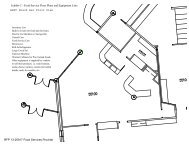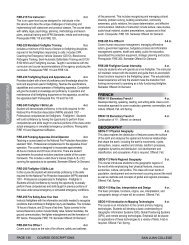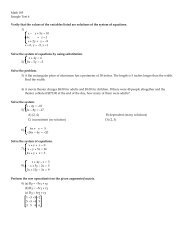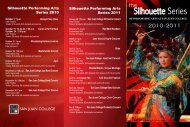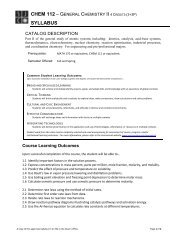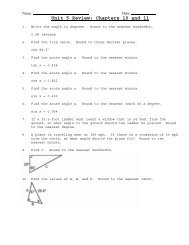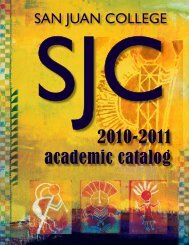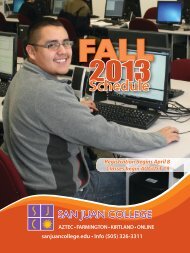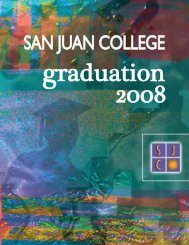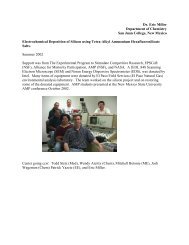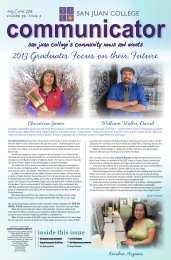AQIP 2007 Systems Portfolio - San Juan College
AQIP 2007 Systems Portfolio - San Juan College
AQIP 2007 Systems Portfolio - San Juan College
You also want an ePaper? Increase the reach of your titles
YUMPU automatically turns print PDFs into web optimized ePapers that Google loves.
<strong>San</strong> <strong>Juan</strong> <strong>College</strong> – <strong>AQIP</strong> <strong>Systems</strong> <strong>Portfolio</strong> – November <strong>2007</strong>methods: (1) top down identification of needs from thestrategic planning process and (2) from surveys andother faculty and student feedback. Recent results ofstudent surveys have resulted in providing additionalKey Delivery IndicatorsProgram enrollmentIn-programCourse evaluationIn-programStudent satisfaction/feedback In-programStudent learning (tests, portfolios) In-programRetention ratesIn-programGraduation ratesOutcomePlacement ratesOutcomeEmployer satisfactionOutcomeTable 1.9 Key Delivery Indicatorsresources in the areas of laboratory assistants andacademic advisement. Key learning support servicesare presented in Table 6.1.Instructional design and a number of services toassist in technology integration for instruction are alsoprovided for faculty (see Table 1.6).Considering the <strong>College</strong>’s reliance on part-time facultyto deliver instructional services to students, theQuality Student Learning Council (QSLC) wasassigned the responsibility of benchmarking andresearching adjunct faculty development programs tocreate effective and efficient recruiting processes,develop appropriate training and professionaldevelopment, and improve systems for evaluation andfeedback. The Research and Report Best Practicesin Adjunct Faculty Development Programs ActionProject was initiated April 2006. The overall goal is toimprove student course completion, student retentionand retention of adjunct faculty. First year results arepresented in 1R3.1P10 <strong>San</strong> <strong>Juan</strong> <strong>College</strong> has had a long history ofexperiential learning or more broadly referred to aslearning outside of the classroom. Evidence of thiscan be seen in numerous areas including thedevelopment of a student activities office and studentgovernment almost since the inception of the college.• Further examples of the college’s commitment toco-curricular and curricular goal alignment can beseen through the Volunteer Center, the outdoorleadership program, peer advisement and peertutoring, a myriad of clubs focused on academicand social interests.• “Co-Curricular Transcripts” - students canofficially document outside class work, studentgovernment and volunteer experience for futureemployers, university admissions, andscholarship applications.• “Service Learning” is a program of the VolunteerCenter designed to connect college curriculumwith the community through community service tofoster civic engagement and responsible.• To further SJC’s student development initiatives,the MUSCL (Members United to StrengthenComprehensive Learning) Student DevelopmentTeam was created in July of 2006 to focus on:• Service Learning• Peer Mentorship• Student Leadership Team• Extended Orientation• “Get Involved” (a clearing house ofopportunities to become involved withcampus life).1P11 The Assessment Committee is charged withmeasuring student learning across disciplines andprograms to determine the extent to which studentlearning demonstrates competency in the CSLOs.Through workshops, in-service activities, and monthlymeetings, the committee encourages faculty toengage in all levels of assessment—classroom,course, and program—using processes appropriatefor each discipline. For some areas, such as nursing,national standardized tests measure students’competency, whereas in areas such as the generaleducation core curriculum, portfolios or capstoneprojects are utilized.For overall institutional assessment of the fiveCSLOs, the committee has chosen to encourage a“culture of evidence” through the use of artifacts. Anartifact is any assignment-driven, student-producedwork such as a project, demonstration, speech,performance, examination, or portfolio, that can beassessed to determine student achievement of one(or more) of the CSLOs. Using artifacts for CSLOassessment preserves our commitment to studentlearning by recognizing and valuing our institution’sspecific needs and circumstances.Proposed Artifact Assessment Process:• Identify a limited number of courses per year on arotating basis from which to select perhaps100 artifacts, total. In three pilot readings, todate, we have collected approximately 50artifacts.o For the May <strong>2007</strong> artifact assessment,the committee contacted 12 instructorsfrom the following disciplines:Automotive, Computer Science, DentalHygiene, Early Childhood Education,English, History, Human Services,Math, Nursing, and Physical Therapy.o 134 students in those classes hadcompleted 50+ credit hours.<strong>AQIP</strong> Category One: Helping Students Learn 8



